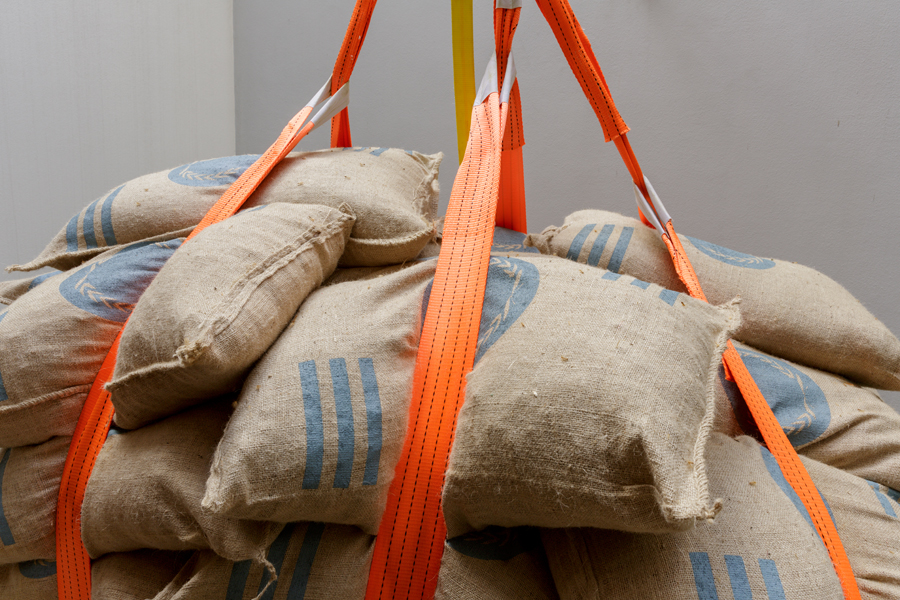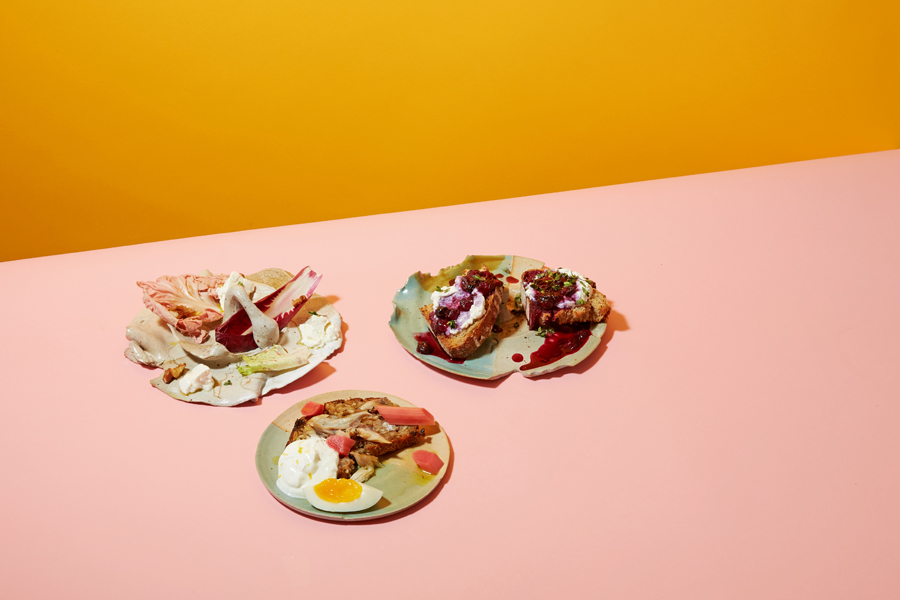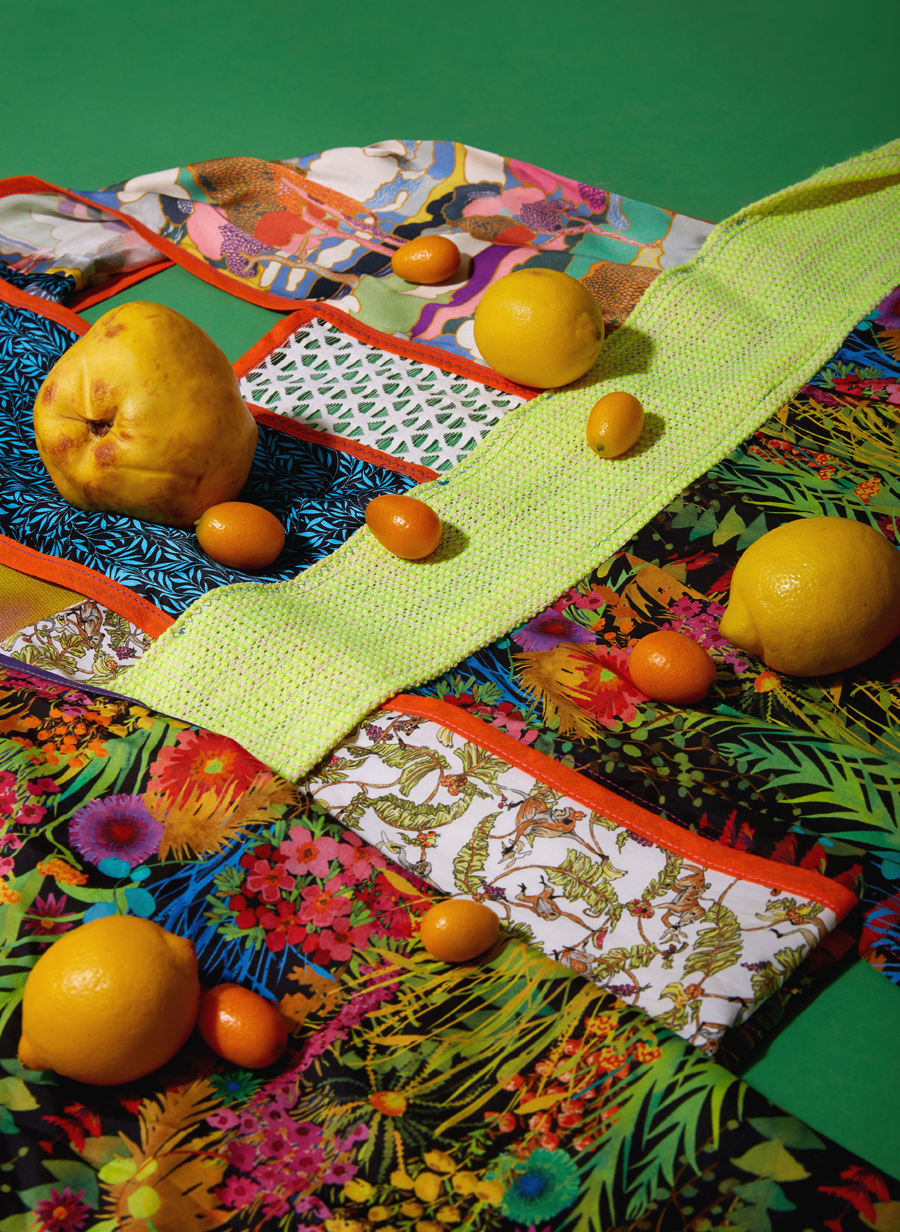What Artists Can Learn from the Pleasure of Food
From artist café Tender Touches to the V&A’s ‘FOOD: Bigger Than the Plate’, the London art world is tackling culinary culture
From artist café Tender Touches to the V&A’s ‘FOOD: Bigger Than the Plate’, the London art world is tackling culinary culture

Is there a better way to initiate a conversation on the topic of food than through the act of eating? Pici, pronounced ‘peachy’, are a kind of thick spaghetti, carved from a sheet of dough into strips and then hand-rolled into irregular strands that have a dense chewy texture when cooked. Like every type of pasta, pici move in their own unique way: they pile onto the plate in uneven heaps and dangle from the fork like lumpen worms. Caked in dark green watercress pesto, they were the central component of an edible portrait of the artist Bea Bonafini, eaten off Bonafini’s Noli Me Mordere (Bite-me-not, 2019) handmade ceramic plates, which bore a resemblance to raw pastry that had been shaped into concentric wells. The dish was served at a recent dinner to launch Tender Touches, a temporary café that runs until the end of June at AMP Gallery in Peckham, where the furniture, food and décor are all made by artists.
Co-curated by Huma Kabakcı, the founder of exhibition platform Open Space, and artist Inês Neto dos Santos (the creator of the pici portrait), Tender Touches, whose name is inspired by the food poems in Gertrude Stein’s Tender Buttons (1914), revolves around the act of eating, and is one of several food-related exhibitions across London this summer, along with a major show at the V&A Museum and a season devoted to the politics of food at Delfina Foundation.

As dusk settled, the candlelit café started to attract attention from passers-by. The preview event I attended was invitation only, but Kabakcı and Neto dos Santos are opening the café Wednesday to Sunday, 10am to 6pm, and offering visitors free coffee in an effort to make it feel inclusive. Neto dos Santos uses hospitality as a model for her art, and says she is especially alert to ‘the way people relate when food is involved in art’. At the dinner, she presented a starter of ferments and pickles as an evocation of her relationship with Kabakcı, explaining that the fermentation process, in which yeasts, bacteria and the environment interact to create texture and flavour, was a metaphor for their collaboration.
Neto dos Santos is also curious about what happens when sensibilities usually registered in the visual realm are transferred to a culinary medium. The second course was a portrait of the artist Marco Palmieri, the suavity of whose Pool Motif (2015) wallpaper (and Tender Touches exhibition poster) Neto dos Santo associated with the scene involving a ripe peach in Luca Guadagnino’s 2017 film Call Me by Your Name: a plate of whipped ricotta and toasted hazelnuts, strewn with halves of fresh apricot. A playful sensuality ran through the event, with Sofia Stevi’s cloth napkins printed with salivating mouths and Lindsey Mendick’s Never Let Me Go (2019) cutlery, whose ceramic handles are cast from gherkins detailed with rows of tiny bumps like taste buds.
For many of us the next meal is only ever a few hours away, so food has personal meaning, but it is also bound up with systems of global production, trade and the environment. The V&A’s new exhibition ‘FOOD: Bigger Than the Plate’, curated by Catherine Flood and May Rosenthal Sloan, explores the topic through more than 70 design and art projects organized into a journey through the main stages of the food cycle from waste to farming, trading and eating.

Among the imaginative uses of human and animal waste is ‘merdacotta’, a material devised in 2015 by cow farmer Gianantonio Locatelli and architect Luca Cipelletti to recycle the residue when energy, heat and fertilizer have been extracted from cow dung. Merdacotta is made into tiles, furniture and homewares as the final step of a virtuous circle that recuperates waste into something useful. At the V&A, a table set with crockery is flanked by a pair of toilet bowls – all merdacotta – in a setup reminiscent of the iconic scene from Luis Buñuel’s film The Phantom of Liberty (1974), in which the norms of eating and shitting are inverted and guests at a posh gathering sit on toilets at the dinner table and bashfully retire to private cubicles to eat.
Offering a series of encounters with ideas and solutions that promise to change the way we eat and live, ‘FOOD: Bigger Than the Plate’ combines the excitement of a trade fair with the esoteric wonder of a specialist food store, although despite being billed as a ‘sensory journey’ the exhibition includes just one opportunity to eat. At the LOCI Food Lab by the Center for Genomic Gastronomy (2014-ongoing), local food systems are explored through the use of bioregional ingredients and each visitor can enjoy a canapé customized according to their answers to a quiz about the way they imagine the future of food. At a spacious bar area, the East London-based cultural enterprise Company Drinks serves free samples of drinks made from foraged fruit and botanicals, highlighting how productive the relationship between the urban and the rural can be. Within the framework of the exhibition, the bar offers a precious opportunity for people to come together and socialize, an essential part of the experience of food, which is also invoked in artist Jasleen Kaur’s The Five K’s (2017), a series of carpets modelled after the physical symbols of the Sikh faith. As Kaur explains, the Axminster-style carpets, popular in many British Asian homes, where the pattern might ‘disguise the odd turmeric stain’, invite people to put their ‘bum on the carpet’, their ‘plate on the floor’ and eat together.
Food is inextricably bound to identity, something Laura Wilson’s project Trained on Veda (2016-ongoing) explores by reviving the recipe of Veda bread, a loaf first made from accidentally sprouted wheat, which was found to have a long shelf-life. At the V&A, a loaf of Wilson’s reverse-engineered Veda bread is presented alongside information about its history: it was first produced in 1900 and later sent to soldiers in the trenches of WWI and sold across the UK. The monopoly of sliced white has pushed Veda out of the mainstream market although a version of it is still available only in Northern Ireland, where Wilson grew up eating it. She is producing loaves in collaboration with arts institutions and bakeries for distribution across the UK mainland.

As a planet we produce enough food to feed our population, yet according to the World Food Programme, one in nine go to bed hungry every night and one in three suffer from some form of malnutrition. This situation is explored in Spanish artist Asunción Molinos Gordo’s exhibition ‘Accumulation by Dispossession’, part of Delfina Foundation’s ‘The Politics of Food’ season. As curator Dani Burrows explained at a lunch to mark the opening of the show, Molinos Gordo’s work addresses the terrible irony that ‘the people involved in food production are often not at the table’.
The concept of accumulation by dispossession, developed in the early 2000s by the Marxist scholar David Harvey, refers to the process by which wealth and power are centralized in the hands of a few by dispossessing public and private entities of their wealth or land. It is a fundamental feature of modern capitalism, generating untold profit. Molinos Gordo explains the show as ‘a collection of facts translated into artefacts’, with practices such as land and water grabbing and the creation of false scarcities articulated in the language of agriculture. Dumping (2014) – referencing how large quantities of crops are introduced into a country at an artificially low cost, thereby cutting local farmers out of the market – consists of an enormous mass of 60 stuffed raffia bags bound by industrial orange straps and lowered into the gallery’s light well.
The relationship between agriculture and the global economy was the subject of an enlightening discussion at Delfina Foundation between Molinos Gordo and Ray Bush, Professor of African Studies and Development Politics at the University of Leeds. Bush showed how the commodification of food is the primary driver of current food crises, and how its expression in practices of accumulation by dispossession is ‘a structural feature of the global economy, and will not be fixed by policy wonks’. Instead, Bush advocates for a major transition, a revolutionary shift into a new global food regime achieved by wresting power from global corporations and putting farmers back in charge of decisions at all levels of production, marketing and trade. Such a major change would affect all areas of society from personal and regional politics to trade and the way we shape our cities, and it is also the goal of the 200 million strong international farmers’ movement La Via Campesina. Founded in 1993 in Mons, Belgium by farmers’ organizations from around the globe, its slogan is ‘globalizing hope, globalizing the struggle!’, and it advocates family-farm-based sustainable agriculture, defends farmers’s seeds against monopolies and campaigns for agrarian reform, women’s rights and the rights of peasants.

The links between the pleasures we seek from handling and eating food and the operations of power are increasingly apparent, with questions around the environmental, economic and ethical implications of food production and consumption making the news daily. Recognizing that pleasure is also part of such mechanisms is crucial to developing a plan for worthwhile change. For Flood and Rosenthal Sloan, to do so is political: as they write in their introduction to the ‘FOOD: Bigger Than the Plate’ catalogue, ‘[p]leasure is a principle at stake in the struggle for greater food democracy and against the increasing commercial colonization of everyday life.’ And there’s no shame in recognising the political value of pleasure in the act of eating; it’s where it all begins.
Main image: David Allen Burns and Austin Young, Fruits from the Garden and the Field (Rainbow), 2019. Courtesy: the artist and Victoria and Albert Museum, London




















